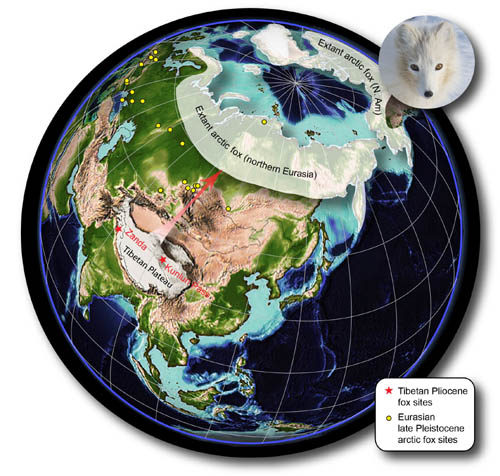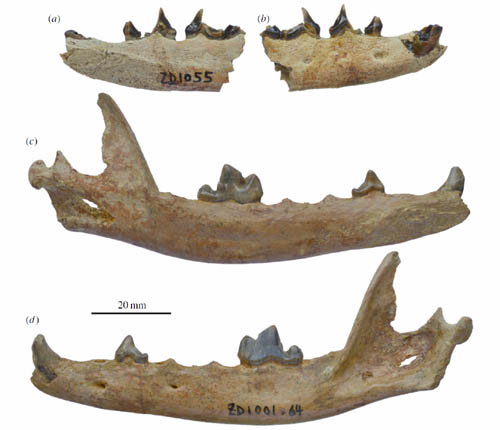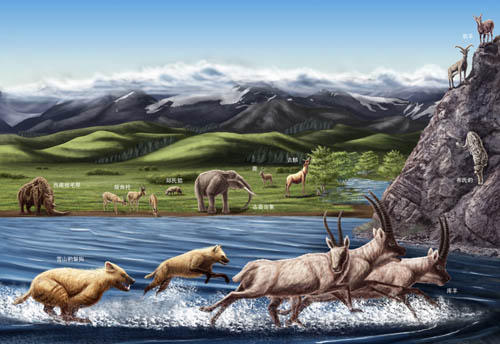| Location: Home > Research > Research Progress |
| Extinct Tibetan Fox Suggests High Tibet Was Cradle of Evolution for Cold-adapted Mammals |
|
For the last 2.5 million years, our planet has experienced cold and warm, millennia-long cycles that collectively have become known as the Ice Age. During cold periods, continental-scale ice sheets blanketed large tracts of the northern hemisphere. As the climate warmed up, these colossal glaciers receded, leaving Yosemite-like valleys and other majestic geologic features behind. The advance and retreat of the ice sheets also had a profound influence in the evolution and geographic distribution of many animals, including those that live today in the Arctic regions. A new study published online June 11 in the Proceedings of the Royal Society B: Biological Sciences identifies a newly discovered 3- to 5-million-year-old Tibetan fox from the Himalayan Mountains, Vulpes qiuzhudingi, as the likely ancestor of the living Arctic fox (Vulpes lagopus), lending support to the idea that the evolution of present-day animals of the Arctic region is intimately connected to ancestors that first became adapted for life in cold regions in the high altitude environments of the Tibetan Plateau. The paper’s lead author is Xiaoming Wang, of the Institute of Vertebrate Paleontology and Paleoanthropology, Chinese Academy of Sciences, and the Natural History Museum of Los Angeles County. Co-authors are Zhijie Jack Tseng (University of Southern California), Qiang Li (Institute of Vertebrate Paleontology and Paleoanthropology), Gary T. Takeuchi (Page Museum at the La Brea Tar Pits), and Guangpu Xie (Gansu Provincial Museum). These writers, on a team with other geologists and paleontologists and led by Wang, uncovered the fossil specimens in the Zanda Basin in southern Tibet in 2010. In addition to the arctic fox, the team also uncovered extinct species of a woolly rhino, three-toed horse, Tibetan bharal (also known as blue sheep), chiru (Tibetan antelope), snow leopard, badger, as well as 23 other mammals. The origin of the cold-adapted Pleistocene megafauna has usually been sought either in the arctic tundra or in the cool steppes elsewhere. But the team’s new fossil assemblage boosts an alternative scenario, which the authors call the “out of Tibet” hypothesis (Deng et al., 2011, Science). It argues that some of the Ice Age megafauna (which included the woolly mammoth, woolly rhino, saber-toothed cat, and others) used ancient Tibet as a “training ground” for developing adaptations that allowed them to cope with the severe climatic conditions. These Tibetan ancestors were thus pre-adapted to cold climates during the Ice Age (2.6-.01 million years ago). Tibet, according to Wang, is a rich but grueling location for paleontological fieldwork. Fifteen summer seasons, and a good deal of luck, have honed his team’s success. The expeditions involve a one-week journey to Lhasa, then a four-day drive into the remote “layer cake” sediments of the Zanda Basin — a drive made in old model Land Cruisers known to get stuck in streams. At more than 4000-meter elevation, it’s difficult to breathe, water freezes overnight in camps, and the team members disband every morning to walk alone in search of fossils. Wang and his team have trained their eyes to search for ancient lake margins, where the megafauna they’re interested in are often found. They alternate camp nights with nights in town, so they keep their strength up for a couple of weeks. “There are a lot of challenges,” Wang said, “but in paleontological terms, it is a relatively unexplored environment. Our efforts are rewriting a significant chapter of our planet’s recent geological history.” This work was supported by the Strategic Priority Research Program of the Chinese Academy of Science, Chinese National Natural Science Foundation, Major Basic Research Projects of the Ministry of Science and Technology of China. Fig. 1 Origin and migration of the arctic fox (Imaged by Xiaoming Wang) Fig. 2 Fossils of Vulpes qiuzhudingi from the Zanda Basin in Tibet, China (Imaged by Xiaoming Wang) Fig. 3 Artist reconstruction of the Zanda fauna from the Pliocene about 5-2.5 million years ago (artist: Julie Selan)
|


